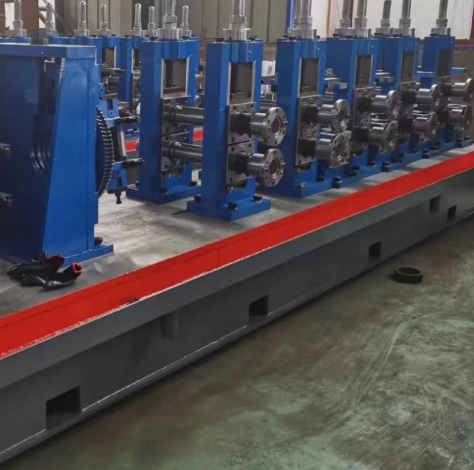Reliable Solutions for High Frequency Welded Pipe Applications
In today’s steel industry, the demand for reliable and efficient piping solutions is rapidly increasing. From construction to energy, companies rely heavily on advanced technologies that deliver both strength and cost-effectiveness. Among the most prominent options, ທໍ່ welded ຄວາມຖີ່ສູງ, welded gas pipe, welded and seamless pipe, ແລະ linepipe stand out for their adaptability and performance. With proven technical parameters and innovative production systems, these pipes continue to shape industrial progress across multiple markets.
Strength and Efficiency in Modern Production
The growth of infrastructure projects and energy pipelines requires materials that are not only strong but also efficient to produce. This is where ທໍ່ welded ຄວາມຖີ່ສູງ demonstrates clear advantages. Manufactured through induction heating, the process ensures rapid welding without compromising quality. Its technical parameters allow flexibility in strip steel width, thickness, and length accuracy, making it ideal for high-volume production. By reducing material waste and optimizing energy use, manufacturers can achieve cost savings while meeting strict industry standards.
Applications of Welded Gas Pipe in Energy Industries
The reliability of welded gas pipe has made it a crucial material for energy distribution systems worldwide. Gas pipelines demand pipes with excellent sealing, consistent thickness, and resistance to both internal pressure and environmental conditions. Welded options provide efficient transport for natural gas and other fuels, maintaining structural integrity under continuous use. Their production process supports long lengths and stable forming speeds, ensuring they can be deployed in extensive networks without frequent jointing. This balance of strength and practicality is why energy companies continue to adopt welded gas pipes for their large-scale projects.

Comparing Welded and Seamless Pipe for Industry Needs
In industrial markets, the choice between welded and seamless pipe often depends on the end-use. Seamless pipes, with their uniform structure, are often selected for high-pressure and high-temperature environments. Welded pipes, however, provide cost-effective alternatives for general transport and construction, while still meeting rigorous standards. Advances in welding technologies have narrowed the gap between welded and seamless pipes in terms of durability and performance. This makes welded pipes a preferred option when balancing affordability and efficiency. Businesses can therefore select based on specific requirements rather than being limited to one option.
Linepipe for Global Infrastructure Development
The role of linepipe in global infrastructure cannot be overstated. Designed for transporting oil, gas, and water across vast distances, linepipe must meet strict specifications regarding steel grade, diameter, and length. High frequency welding processes allow linepipes to maintain uniform wall thickness and smooth inner surfaces, which reduce friction during fluid transport. Additionally, the ability to produce pipes in long lengths with high accuracy ensures efficiency in laying down pipeline networks. For international markets, linepipe represents both technological advancement and practical utility, enabling safe and reliable transport of resources across borders.
High Frequency Welded Pipe FAQs
What is the main difference between welded and seamless pipes?
The key difference lies in the manufacturing process. Seamless pipes are formed by extrusion without a welded seam, giving them high strength and resistance to pressure. Welded pipes, on the other hand, are created by rolling steel sheets and welding them along the seam. With modern technology, welded pipes can achieve strength and durability close to seamless alternatives but at a lower cost.
Why is high frequency welded pipe preferred in large-scale production?
High frequency welding enables faster and more efficient production compared to traditional methods. It reduces energy consumption while ensuring strong, consistent welds. The ability to maintain precise dimensions and accommodate a wide range of pipe sizes makes it especially suitable for mass production in industries such as construction, automotive, and energy.
What industries use welded gas pipes most commonly?
Welded gas pipes are primarily used in energy sectors, including natural gas distribution, oil refineries, and chemical plants. Their durability and pressure resistance make them reliable for transporting gas over long distances. They are also increasingly used in urban infrastructure for safe delivery of fuel to households and businesses.
Are welded pipes suitable for high-pressure applications?
Yes, modern welded pipes are engineered to handle moderate to high pressures, depending on their specifications. While seamless pipes are often the first choice for extreme conditions, welded pipes now meet many high-pressure requirements thanks to advances in welding processes and quality control standards.
What makes linepipe essential in international trade and infrastructure?
Linepipe serves as the backbone of global oil and gas transport systems. Its ability to carry large volumes of resources across long distances ensures energy security and supports economic development. The precision manufacturing of linepipes allows them to withstand environmental challenges while maintaining efficiency in flow, making them indispensable for cross-border infrastructure projects.
-
Precision Cutting Machinery: From Low-Speed Saws to Advanced Flying Shearsຂ່າວAug.26,2025
-
Machinery for Pipe Fabrication: From Welding to Cuttingຂ່າວAug.26,2025
-
Leading Manufacturers of Pipe and Tube Machineryຂ່າວAug.26,2025
-
Key Manufacturers of Tube and Pipe Processing Machineryຂ່າວAug.26,2025
-
Best Machinery for Metal Pipe Fabrication: Cutting, Rolling, and Weldingຂ່າວAug.26,2025
-
Advanced Cutting Solutions: Exploring CNC Cold Saws and Flying Saws for Industrial Needsຂ່າວAug.26,2025


